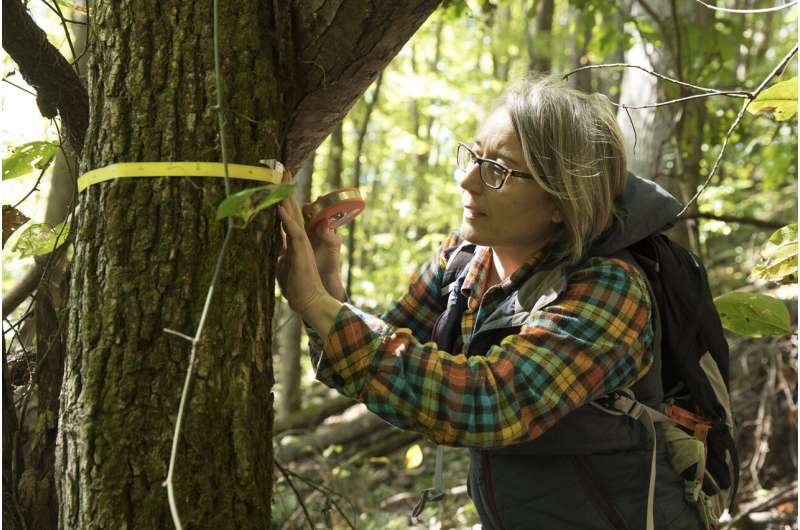This article has been reviewed according to Science X's editorial process and policies. Editors have highlighted the following attributes while ensuring the content's credibility:
fact-checked
peer-reviewed publication
trusted source
proofread
Land-use strategies, nutrient conditions contribute to oak decline

New research led by a University of Georgia ecologist sheds light, for the first time, on how land-use disturbance and nutrient conditions play a role in the decline of oak forests. The most promising strategy to address this decline is reduced cutting.
Oak trees provide high-quality timber, support a complex food web and are resilient to drought and fire. But oaks are in decline in recent years, while species like maple and tulip poplar are increasing. The study, led by Nina Wurzburger and published in the Journal of Applied Ecology, is the first to evaluate how land-use history and the presence of more nitrogen may create conditions that disfavor oak while favoring its competitors.
The legacy effects of trees
For the study, the researchers examined new data as well as land-use strategies employed over nearly a century at the Coweeta Hydrologic Laboratory in western North Carolina.
"Having this long-term record that goes back almost 90 years—it's a goldmine of information," said Wurzburger, associate professor at the Odum School of Ecology. "It allowed us to compare three different land-use strategies and ask how the forest has changed in response to those disturbances."
The Coweeta Basin encompasses 1,626 hectares and was the site of the Coweeta Long Term Ecological Research program, where U.S. Forest Service scientists installed permanent plots in the 1930s that have been monitored periodically ever since. The basin was selectively logged early in the 20th century, providing the first set of land-use data for the team's study. From 1958 to 1968, a section of land was cleared, burned and converted for agricultural use, then abandoned. The third land-use scenario was a clear cut that took place in the 1970s.
In addition to existing data, Wurzburger gathered new data at Coweeta on the black locust tree, a native species that proliferates after a disturbance but persists for only a couple of decades before being outcompeted by other trees. Specifically, she examined whether the presence of black locust—which fixes nitrogen in soil—creates nutrient conditions that disfavor oak while favoring its competitors.
A related factor is how trees acquire nutrients based on the types of fungi with which they associate. Trees either associate with arbuscular mycorrhizal (AM) or ectomycorrhizal (ECM) fungi, with prevailing theory suggesting that each creates soil nutrient conditions that favor themselves over the other type. Oaks and hickories are the dominant ECM species, and maple and tulip poplar are AM species.
"If an AM tree dominates a forest, it tends to promote rapid nitrogen cycling, which favors itself because its fungi prefer freely available nitrogen," Wurzburger said. "If an ECM tree dominates, it suppresses nitrogen cycling, leaving nutrients bound up in organic matter. ECM fungi are equipped to break down organic matter and mine the nitrogen out of it, but they cost the tree more carbon. That strategy is not favorable if there's a lot of available nitrogen in the soil."
The study's results revealed that the plentiful—although short term—presence of black locust trees after a land disturbance creates nutrient conditions favorable to AM species, like maple and tulip poplar, and unfavorable to ECM species like oak and hickory. Those effects can last for decades.
"Black locust trees that grew in a forest 30, 50 or even 90 years ago are still having effects on current trees," she said.
Fire factor
One strategy that makes soil more favorable for oaks is fire. Burning helps remove maple and tulip poplar, which are not fire adapted, and returns nitrogen back to the atmosphere. The oak forests in decline now would have burned relatively frequently over thousands and thousands of years, according to Wurzburger.
"Oak and hickory are really fire-adapted trees," she said. "It's an anomalous period that we're living in now, where fire is not prevalent on this landscape. Prescribed burning is really well accepted in south Georgia, especially in the longleaf pine systems in the coastal plain. Land managers are well aware of the benefits of fire to those fire-adapted ecosystems. But up in the Appalachians, it's harder to implement prescribed fire, and its benefits are less appreciated."
The exclusion of fire plus the addition of more nitrogen means that across the East, maple and tulip poplar have been increasing in dominance at the expense of oak and hickory trees, according to Wurzburger. That leaves land management as the strategy with the most potential for preserving oak forests.
But results of the study revealed that oak trees at Coweeta are declining in all land-use scenarios. The agricultural abandonment scenario fully favored maple and tulip poplar, such that they now dominate the forest. After the clear-cut, the forest is now half oak and hickory trees.
Selective cutting led to the least change—maple and tulip poplar now account for a third of the forest biomass, but this is twice as much as was present in the 1930s.
The study's findings also have implications for how to harvest timber while maintaining oaks. Black locust's effects on oaks are not always negative. "Selectively cutting trees at low levels was the only scenario where oak increased when black locust was historically present," Wurzburger said. "This suggests there might be a sweet spot for oak regeneration—not too much light and just enough nitrogen to help them ward off their competitors."
More information: Nina Wurzburger et al, Forest mycorrhizal dominance depends on historical land use and nitrogen‐fixing trees, Journal of Applied Ecology (2023). DOI: 10.1111/1365-2664.14443
Journal information: Journal of Applied Ecology
Provided by University of Georgia



















